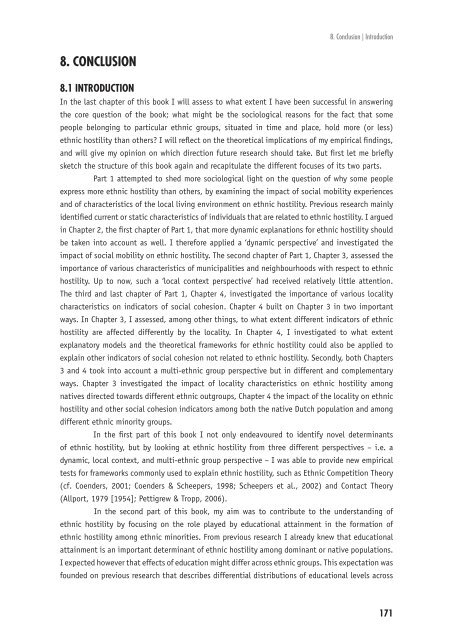Ethnic Hostility among Ethnic Majority and Minority Groups
Ethnic Hostility among Ethnic Majority and Minority Groups
Ethnic Hostility among Ethnic Majority and Minority Groups
You also want an ePaper? Increase the reach of your titles
YUMPU automatically turns print PDFs into web optimized ePapers that Google loves.
8. CONCLUSION<br />
8.1 INTRODUCTION<br />
8. Conclusion | Introduction<br />
In the last chapter of this book I will assess to what extent I have been successful in answering<br />
the core question of the book; what might be the sociological reasons for the fact that some<br />
people belonging to particular ethnic groups, situated in time <strong>and</strong> place, hold more (or less)<br />
ethnic hostility than others? I will refl ect on the theoretical implications of my empirical fi ndings,<br />
<strong>and</strong> will give my opinion on which direction future research should take. But fi rst let me briefl y<br />
sketch the structure of this book again <strong>and</strong> recapitulate the different focuses of its two parts.<br />
Part 1 attempted to shed more sociological light on the question of why some people<br />
express more ethnic hostility than others, by examining the impact of social mobility experiences<br />
<strong>and</strong> of characteristics of the local living environment on ethnic hostility. Previous research mainly<br />
identifi ed current or static characteristics of individuals that are related to ethnic hostility. I argued<br />
in Chapter 2, the fi rst chapter of Part 1, that more dynamic explanations for ethnic hostility should<br />
be taken into account as well. I therefore applied a ‘dynamic perspective’ <strong>and</strong> investigated the<br />
impact of social mobility on ethnic hostility. The second chapter of Part 1, Chapter 3, assessed the<br />
importance of various characteristics of municipalities <strong>and</strong> neighbourhoods with respect to ethnic<br />
hostility. Up to now, such a ‘local context perspective’ had received relatively little attention.<br />
The third <strong>and</strong> last chapter of Part 1, Chapter 4, investigated the importance of various locality<br />
characteristics on indicators of social cohesion. Chapter 4 built on Chapter 3 in two important<br />
ways. In Chapter 3, I assessed, <strong>among</strong> other things, to what extent different indicators of ethnic<br />
hostility are affected differently by the locality. In Chapter 4, I investigated to what extent<br />
explanatory models <strong>and</strong> the theoretical frameworks for ethnic hostility could also be applied to<br />
explain other indicators of social cohesion not related to ethnic hostility. Secondly, both Chapters<br />
3 <strong>and</strong> 4 took into account a multi-ethnic group perspective but in different <strong>and</strong> complementary<br />
ways. Chapter 3 investigated the impact of locality characteristics on ethnic hostility <strong>among</strong><br />
natives directed towards different ethnic outgroups, Chapter 4 the impact of the locality on ethnic<br />
hostility <strong>and</strong> other social cohesion indicators <strong>among</strong> both the native Dutch population <strong>and</strong> <strong>among</strong><br />
different ethnic minority groups.<br />
In the fi rst part of this book I not only endeavoured to identify novel determinants<br />
of ethnic hostility, but by looking at ethnic hostility from three different perspectives – i.e. a<br />
dynamic, local context, <strong>and</strong> multi-ethnic group perspective – I was able to provide new empirical<br />
tests for frameworks commonly used to explain ethnic hostility, such as <strong>Ethnic</strong> Competition Theory<br />
(cf. Coenders, 2001; Coenders & Scheepers, 1998; Scheepers et al., 2002) <strong>and</strong> Contact Theory<br />
(Allport, 1979 [1954]; Pettigrew & Tropp, 2006).<br />
In the second part of this book, my aim was to contribute to the underst<strong>and</strong>ing of<br />
ethnic hostility by focusing on the role played by educational attainment in the formation of<br />
ethnic hostility <strong>among</strong> ethnic minorities. From previous research I already knew that educational<br />
attainment is an important determinant of ethnic hostility <strong>among</strong> dominant or native populations.<br />
I expected however that effects of education might differ across ethnic groups. This expectation was<br />
founded on previous research that describes differential distributions of educational levels across<br />
171












